|
FEMINIST WRITER OF THE MONTH - PENNY COLMAN
AUTHOR OF
Elizabeth Cady Stanton and Susan
B. Anthony: A Friendship That Changed the World.
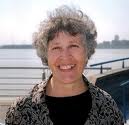 In about twenty years I have written
“a pile of books” (my partner’s phrase) about women and their lives, including Rosie
the Riveter: Women Working on the Home Front in World War II and Elizabeth Cady Stanton and Susan B. Anthony: A Friendship That Changed the World. Why? Personally I was undoubtedly making up for years of deprivation, but when I realized
that the deprivation was widespread I became mission-driven to fill the void. In about twenty years I have written
“a pile of books” (my partner’s phrase) about women and their lives, including Rosie
the Riveter: Women Working on the Home Front in World War II and Elizabeth Cady Stanton and Susan B. Anthony: A Friendship That Changed the World. Why? Personally I was undoubtedly making up for years of deprivation, but when I realized
that the deprivation was widespread I became mission-driven to fill the void.
I was born Penelope Granger Morgan in 1944 in Denver, Colorado, and grew up in
North Warren, Pennsylvania, in a time when women’s history was an unheard-of concept, especially in my male-centered
family, what with my three brothers, Freudian psychiatrist father, and immigrant mother, an artist who took on
the trappings of a post-war homemaker. And, women’s history remained an unheard-of-concept throughout my college
and graduate school years in the 1960s, despite the fact that I earned a bachelor’s degree in history and a master
of arts in teaching social studies.
Penny with her brothers, 1948
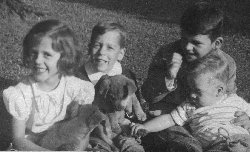 |
So, it’s no wonder that for many years, I believed that men’s words, needs, and deeds
were what mattered most. After all, men are featured in history books. Statues of men dominate our public spaces.
In everyday life, men are the majority of politicians, preachers, doctors, lawyers, plumbers, mechanics, and the
experts on everything from money to child rearing. Men make the laws and enforce them. Their stories dominate the
movie screen. Their voices monopolize the radio waves. Men’s pictures and activities appear most frequently on
television and in magazines and newspapers—even on the obituary page. Men’s feats are the focus of public holidays
and celebrations. So, no wonder I believed that men’s words, needs, and deeds were what mattered most in life.
That belief was upended by the Second Wave of the women’s movement, although not
immediately because in the mid-1960’s I was preoccupied with coping with the unexpected death of my beloved brother
Jon and my father’s diagnosis of terminal cancer, which had prompted him to pressure me to accept a marriage proposal
in order to provide a family for my soon-to-be-widowed mother and fatherless sister (Cam was born in 1962, the
year I graduated from high school). Dutifully in 1966 I married a Presbyterian minister, and had three children:
Jonathan in 1969, (the year my father died), and David and Stephen in 1970.
Given my minimally religious upbringing and skeptical mindset, I wasn’t prepared,
or even suited, for life as a minister’s wife, but like my mother I took on the trappings of the role and threw
myself into it.
We spent five years in Buffalo, New York, where some of the older members of the
congregation dubbed me a “women’s libber,” although I never quite understood why since all I remember is changing
diapers, diapers, and more diapers. The next church was in Oklahoma City and we arrived there in 1973, a year after
Oklahoma became the first state to defeat the Equal Rights Amendment.
"Penny Colman off to take
aerial photographs of a historical site."
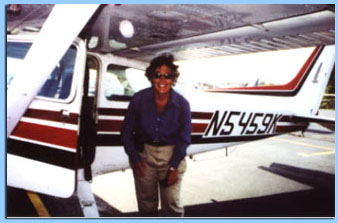 |
In the summer of 1975, we spent a week at Ghost Ranch, a retreat and educational
center run by the United Presbyterian Church, where I heard Letty Russell, a feminist theologian, talk about liberation
theology. Inspired, I returned home and wrote Knowing Me and You, a multi-week course on understanding gender role socialization that I taught in various
adult education venues. I also formed The New Image Players, an all-women drama group, which gave many performances
of a one-act play I wrote, Dare To Seek,
which focused on Jesus’ interactions with women.
The play opened with two actors who alternated between calling out the names of
Biblical women and reciting religious strictures against women. Rose, an African American woman, typically played
Jesus, and K.C., who was pregnant, played Mary. The cast included a musician, medical student, retired teacher,
and two mothers and their teenage daughters. Mostly we were well received, although at a performance in Stillwater,
women wearing aprons showed up to launch a pr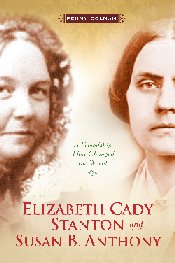 otest,
which included harassing my sons who were passing out programs. otest,
which included harassing my sons who were passing out programs.
In 1978, we moved back to the East Coast where I held a series of jobs, including
one as a program manager of a national project to deal with racism and sexism in the United Presbyterian Church
and another as the executive director of an anti-poverty agency. Then in 1987, as my sons were graduating from
high school and leaving for college, I embarked on a career as a full-time freelance writer. I wrote personal essays
and research-based articles on a variety of subjects for popular magazines. (Having noticed that women experts
were rarely cited or quoted in articles, I made sure I used only women experts.)
In 1990, I started my first biography of a woman, Breaking
the Chains: The Crusade of Dorothea Lynde Dix. Dix, the 19th century social
reformer who led a forty-year crusade for humane treatment of people with mental illness, had come to my attention
during my earlier stint as a history teacher in an all-boys Roman Catholic high school when a number of my students
chose Dix for their paper on a 19th century social reformer. The fact that I later found out that her popularity
was due to the existence of a paper written by one of their older brothers, didn’t dissuade me from selecting her
because I was curious about her and her crusade, having growing up on the grounds of a mental hospital where my
father worked.
That same year was the premier of Ken Burns’s five-part television series, “The
Civil War.” Since Dix had served as the Superintendent of the Female Nurses of the Army during the Civil War, I
decided to watch it.
I was outraged; Burns’s presentation made it seem as if all the women in America
had been relocated to a far-off island for the duration, and his brief mention of Dix was misogynistic. Coincidentally,
I happened to know a woman who had worked on the series with Burns, so I asked her, “Did anyone ask Ken about including
women in the film?”
“Yes,” she replied. “But he said ‘Women didn’t do anything during the war.'”
That prompted me to write my next book, Spies:
Women in the Civil War.
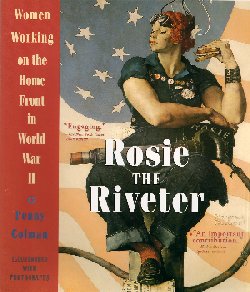 At the same
time, I was writing fiction and nonfiction for children’s magazines, which was really fun. In 1993, I wrote a cover
story “Girls and Sports” for Sports Illustrated for Kids. Shortly before publication, the executive editor, who
was worried about alienating male readers by featuring girls on the cover, proposed replacing the cover photograph
of two young female athletes with a male football player. Outrageous, I told him; my sons would be insulted by
his assumption, plus, I pointed out, Title IX was passed in 1972—get a grip! I not only won that argument, but
also I won the Miller Lite Women’s Sports Journalism Award for the cover story. At the same
time, I was writing fiction and nonfiction for children’s magazines, which was really fun. In 1993, I wrote a cover
story “Girls and Sports” for Sports Illustrated for Kids. Shortly before publication, the executive editor, who
was worried about alienating male readers by featuring girls on the cover, proposed replacing the cover photograph
of two young female athletes with a male football player. Outrageous, I told him; my sons would be insulted by
his assumption, plus, I pointed out, Title IX was passed in 1972—get a grip! I not only won that argument, but
also I won the Miller Lite Women’s Sports Journalism Award for the cover story.
Immersing myself in women’s words, needs, and deeds inspired me to adopt the practice
of evoking a woman’s name to identify a contemporary situation or behavior. For example, if I labeled something
as “a Fannie Lou Hamer,” that meant standing up for what was right despite the danger; “doing a Frances Perkins”
referred to being strategic; “a Mother Jones,” signified resilience; Madam C. J. Walker, was a prompt for financial
solvency and generosity, and the Rosies evoked a can-do-anything attitude. I gleaned life lessons and inspiration,
which I’ve incorporated into my multimedia presentation, “Celebrating Women” that features photographs I’ve taken
during twenty years of road trips in search of landmarks to women, including statues, street signs, gravestones,
and historic sites.
I decided to write Girls: A History of
Growing Up Female in America when those words suddenly popped up in my
brain. I had just given a presentation about Rosie the Riveter: Women Working
on the Home Front in World War II to students at Nontraditional Employment
for Women, an agency in New York City that trains women to do hard hat jobs. Standing at the corner of Broadway
and Twentieth Street, I was thinking about the young woman who had vociferously interrupted me. “So,” she said
waving her arm toward the screen with images of women workers, “you’re saying women have done these jobs before,
right?”
“Right,” I replied.
“Then why do we keep having to prove ourselves on the job?” interjected another
woman.
“That’s her point,” replied the first woman with a nod of her head in my direction.
“We don’t! Women already have. It’s here in this book.” In retrospect, I think, that incident precipitated the
phrase—girls, a history of growing up female in America-- because it underscored the crucial connection between
women’s history and activism. Women’s history is an antidote against taking hard won gains for granted and against
being duped into thinking that we have to keep proving ourselves.
With the exception of Fannie Lou Hamer and the Fight for the Vote,
I’ve done the picture research and taken photographs for my books, 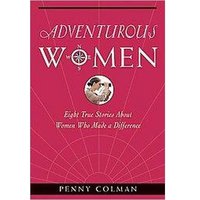 which are replete with images, including many of girls and women. Where the Action Was: Women War Correspondents in World War II
is particularly stunning with photographs by legendary photo-journalists such as Lee Miller, Margaret Bourke-White,
and Dickey Chapelle. Recently I narrated a documentary, “Pioneering Women War Correspondents,” based on my book
and produced by Milena Jovanovitch for the Newswomen’s Club of New York, which can be seen at www.newswomensclubnewyork.com. which are replete with images, including many of girls and women. Where the Action Was: Women War Correspondents in World War II
is particularly stunning with photographs by legendary photo-journalists such as Lee Miller, Margaret Bourke-White,
and Dickey Chapelle. Recently I narrated a documentary, “Pioneering Women War Correspondents,” based on my book
and produced by Milena Jovanovitch for the Newswomen’s Club of New York, which can be seen at www.newswomensclubnewyork.com.
During these years, my sons completed college and graduate school and got married
and I got divorced. I am now happily living with my partner Linda Hickson.
My first grandchild—Sophie—was born in 2003 and it was to her that I dedicated
Adventurous Women: Eight True Stories About Women Who Made a Difference, which she proudly calls “her” book. She was three years old when I started my forthcoming
book, Elizabeth Cady Stanton and Susan B. Anthony: A Friendship That Changed
the World and six-years old when I finished. Together we crafted the dedication:
To everyone who has fought
and who is fighting and who will fight
for the rights of women everywhere.
A Complete List of Penny's books is at: www.pennycolman.com
Contact Penny: pennycolman@gmail.com
I launched a Facebook Fan Page for my forthcoming
book: Elizabeth Cady Stanton and
Susan B. Anthony: A Friendship That Changed the World at:
http://www.facebook.com/pages/Penny-Colman/121670284513664
Comments to Jacqui Ceballos: jcvfa@aol.com
Back to VFA Fabulous Feminists
Table of Contents
|